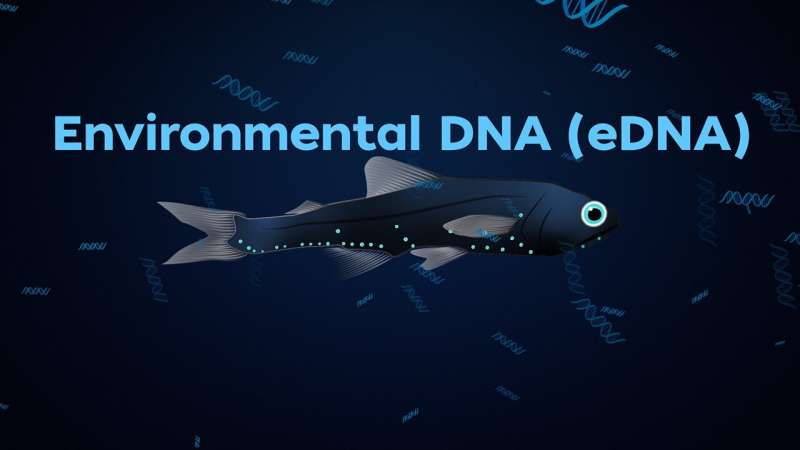Environmental DNA is a reliable way to learn about migration from the ocean twilight zone

The mid-ocean "twilight zone" holds the key to several tantalizing questions about the marine food web and carbon-sequestering capacity of the ocean. But studying this vast and remote area is extremely difficult. Many inhabitants of the twilight zone are easily destroyed during sampling—or are quick to avoid any disturbance—so it's difficult to sample them with traditional nets. Advances in acoustics have enabled more accurate estimates of biomass, but questions about the diversity and distribution of species within that biomass remain unanswered.
That knowledge gap is beginning to close, thanks to the genetic material—from scales, fecal pellets, or bits of tissue—creatures shed as they move through the water. The resulting trail of environmental DNA, or eDNA, gives researchers clues about which species are in that water–and their relative abundance. In a paper published Thursday, October 28 in Scientific Reports, researchers at the Woods Hole Oceanographic Institution found that changes in the concentration of eDNA in the ocean accurately reflects the movement of creatures as they travel between the twilight zone and surface.
"A major finding of our paper is that the eDNA signal doesn't go away immediately if the animal moves up or down in the water column," said Elizabeth Andruszkiewicz Allan, a WHOI postdoctoral fellow during the study and currently a postdoc at the University of Washington. "That helps us answer some big questions we can't answer with net tows or acoustic data. Which species are migrating? What percentage of them migrate each day? And who is an early or late migrator?"
Allan and co-author Weifeng "Gordon" Zhang, a WHOI physical oceanographer, utilized a computer model to simulate what happens to eDNA in the water column after it is shed by the host animal. They found that physical processes—currents, wind, and mixing—and settling of particles did not have a significant impact on the vertical distribution of the eDNA. In fact, most eDNA signals remained within 20 meters (66 feet) of where they were first shed, meaning that changes in eDNA concentration can reliably be used to determine where certain species live at different times of the day, the amount of time they spend at those depths, and the percentage of certain species that migrate from the twilight zone to the surface.
"Before this work, we couldn't confidently say what happened to the eDNA shed by twilight zone species. But a very clear pattern showed up in the model, providing a baseline understanding of the concentration of eDNA between the surface and deep layers over time," said Zhang. "With this new knowledge, field researchers will be able to target where they take the precious water samples so they can identify the migrating species and estimate the percentage of animals in each species group that migrate each day."
As one of the first studies to model eDNA concentration, the researchers note that more field data is needed to help test the model. However, these promising results show just how useful eDNA can be for studying animal migration and carbon sequestration in difficult-to-access parts of the ocean like the twilight zone.
"These modeling results provide a foundation for which we'll be able to more efficiently study the ecology of the ocean twilight zone," said Annette Govindarajan, a WHOI molecular ecologist and co-author of the paper. "It sets up some experiments for future directions, some of which we've already started working on."
More information: Elizabeth Andruszkiewicz Allan et al, Modeling characterization of the vertical and temporal variability of environmental DNA in the mesopelagic ocean, Scientific Reports (2021). DOI: 10.1038/s41598-021-00288-5
Journal information: Scientific Reports
Provided by Woods Hole Oceanographic Institution



















